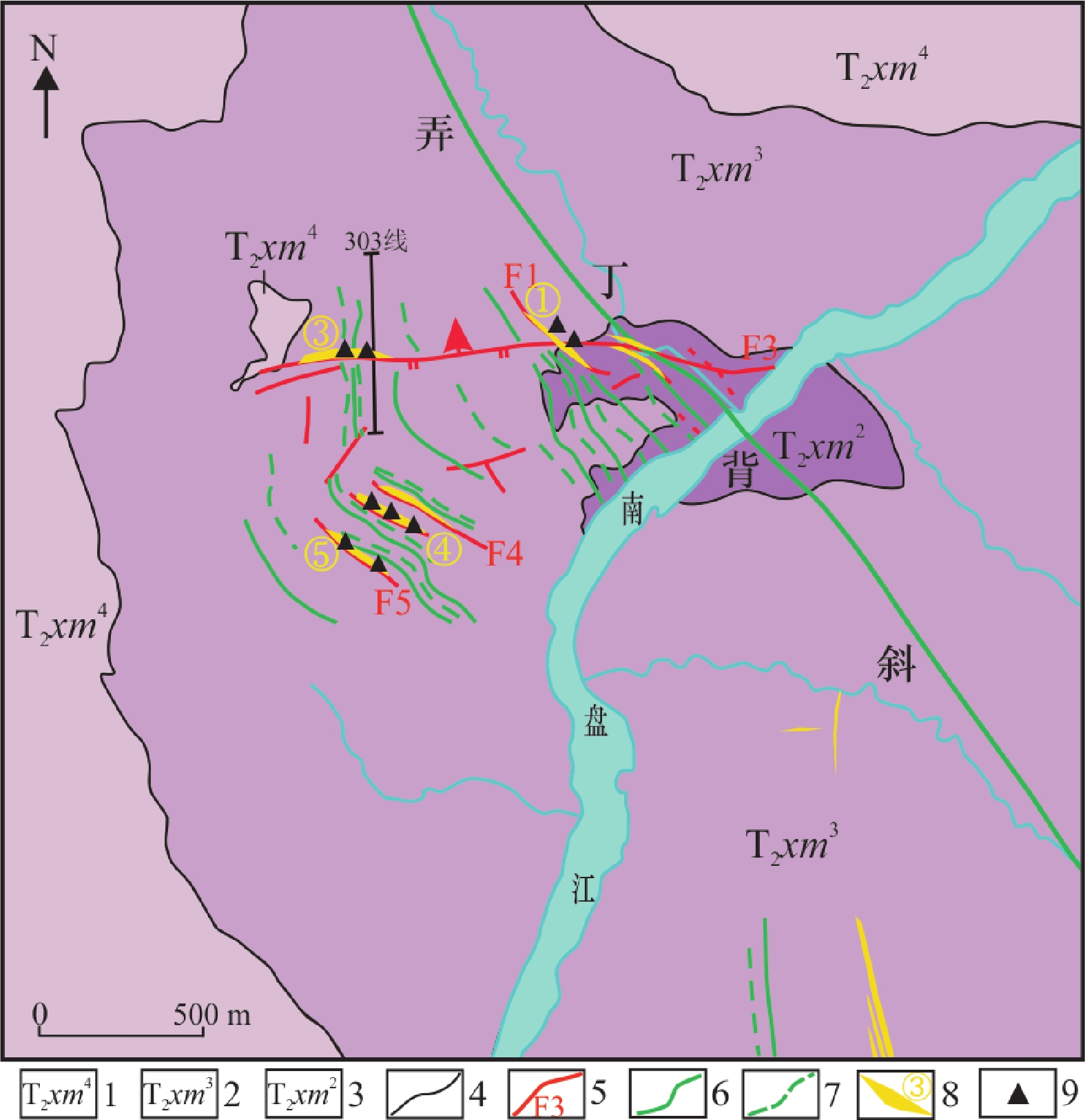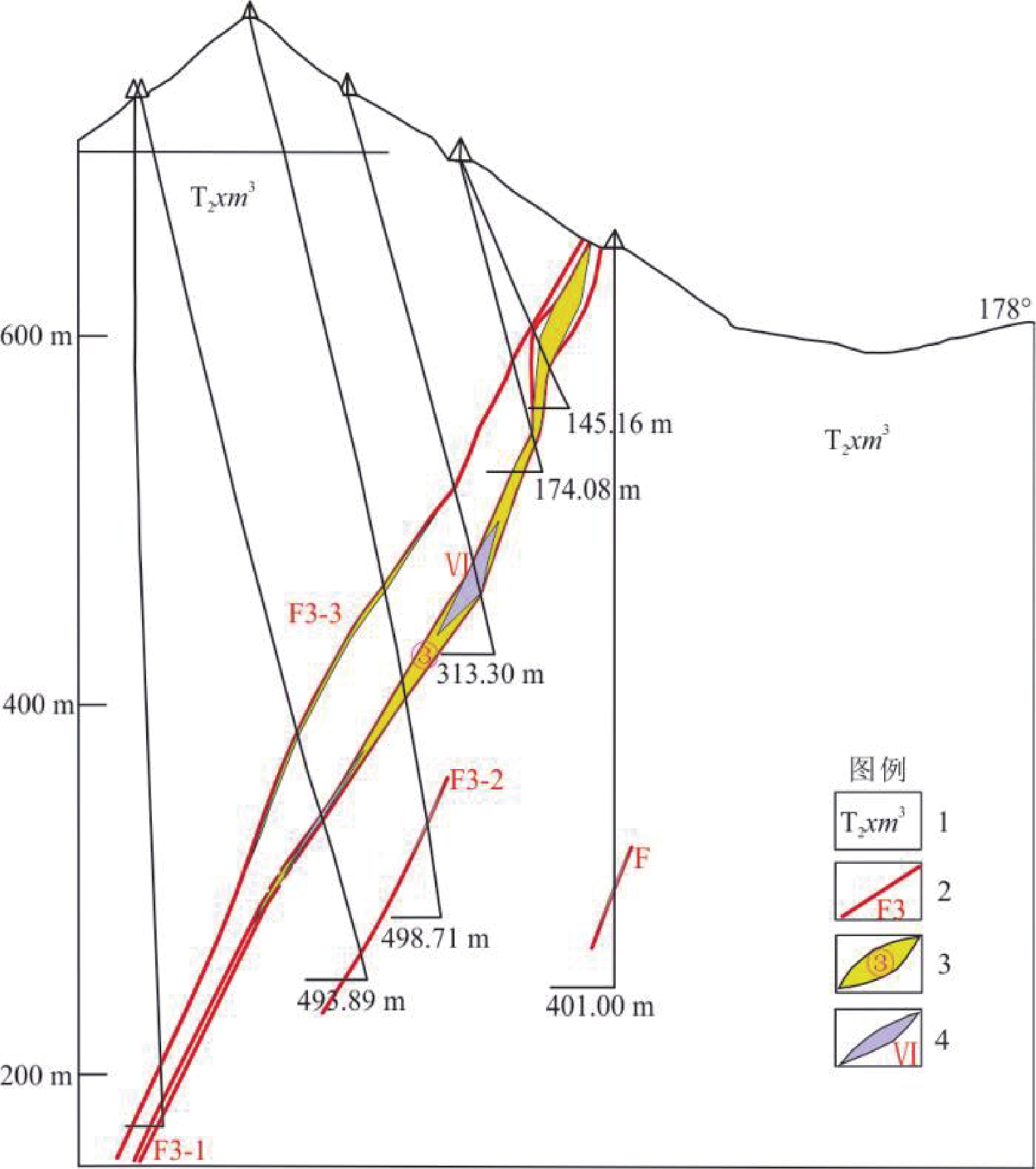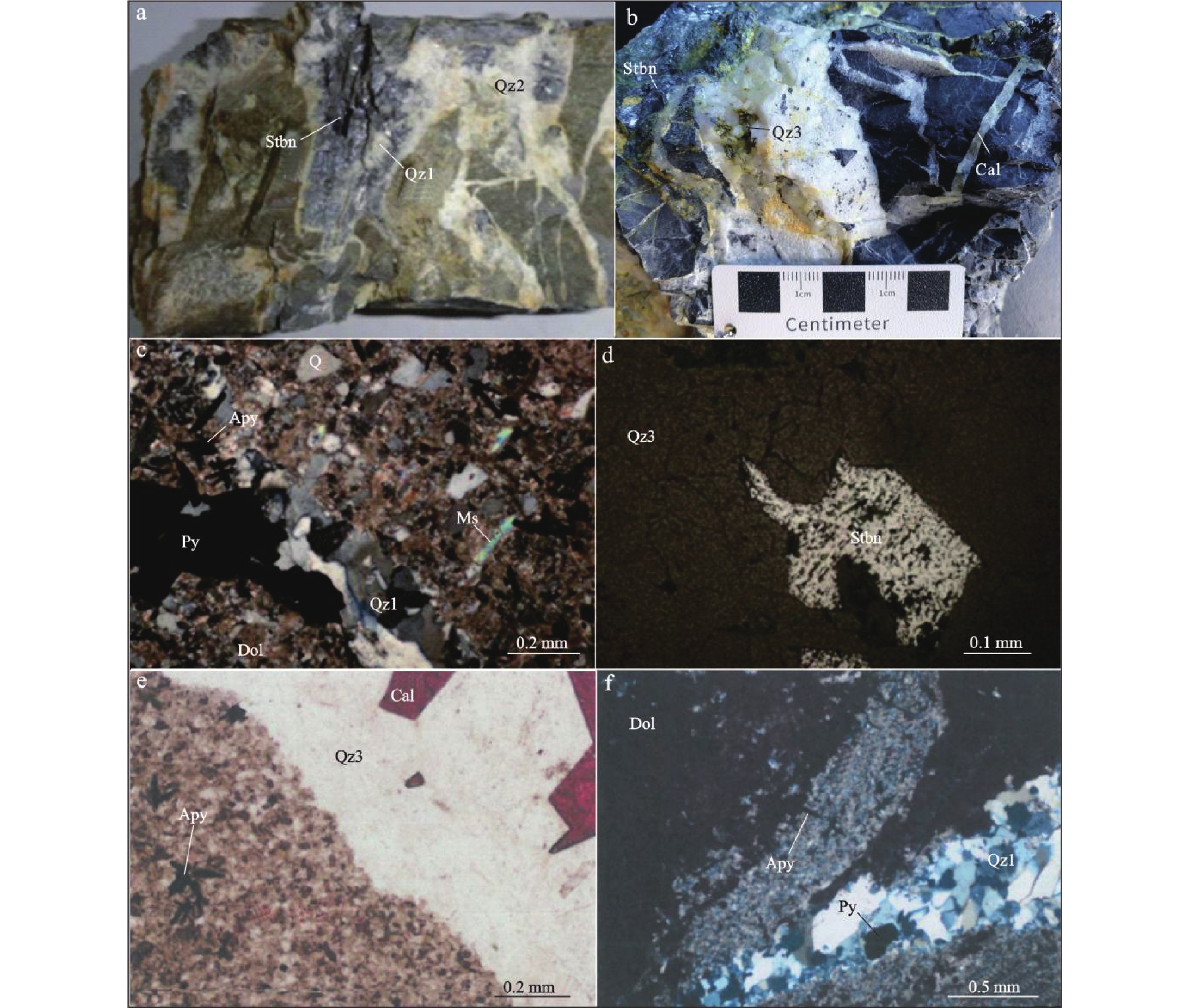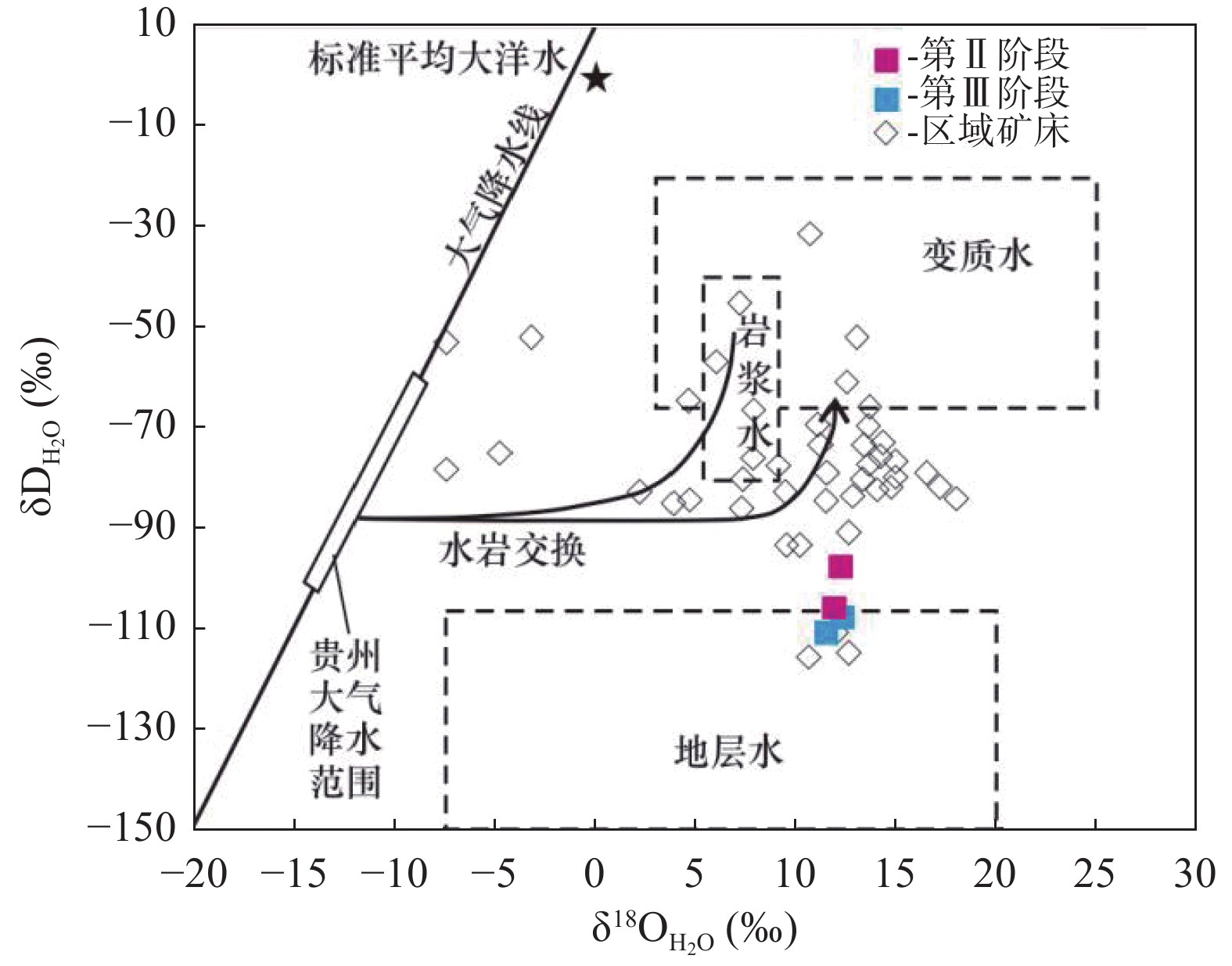Geochemical Characteristics and Genetic Indications of Trace Elements and H-O Isotopes in Quartz of Baidi Gold Deposit, Guizhou Province
-
摘要:
贵州百地金矿床位于右江盆地中部,是以细碎屑岩为赋矿围岩、受陡倾斜断褶带构造系统控制的典型中型金锑共生矿床。本文以该矿床各热液阶段石英为研究对象,分析其微量、稀土元素含量和H-O同位素特征,探讨成矿流体来源及其演化过程。结果显示:各阶段石英均富集Sb、As、Cd、Ge、W、Li,强烈亏损Be、Nb、Zr、Hf;各阶段石英稀土含量及配分曲线差别较大:Ⅰ阶段石英稀土配分曲线呈较明显右倾,LREE富集,Ce异常不明显,具弱Eu负异常;Ⅱ阶段石英稀土配分曲线呈较平缓右倾,Ce和Eu异常不明显;Ⅲ阶段稀土配分曲线呈“上凸型”,MREE富集,具有微弱Ce正异常和明显Eu正异常。研究表明:成矿流体具有明显的混合成因,为以地层建造水为主,含少量深部岩浆流体与基底变质水的混合流体;Ⅰ阶段流体具还原、酸性特征;Ⅱ阶段流体继承了Ⅰ阶段流体特征,环境向氧化、碱性转变,使Au等元素发生沉淀,REE和Y进入Ⅲ阶段流体;Ⅲ阶段流体处于氧化、碱性环境,造成Sb的沉淀和围岩Sr等元素的进入;Ⅱ阶段到Ⅲ阶段流体环境转变和深部基底变质水减少,说明百地金矿床热液成矿作用是多期次的,深部岩浆流体和基底变质水在成矿流体中的参与度随成矿过程的演进而逐渐降低。
Abstract:The Baidi gold deposit of Guizhou Province is a typical gold-antimony co-occurrence medium deposit located in the middle of Youjiang Basin, with fine clastic rock as its host rock and controlled by the tectonic system of steep inclined fault-fold belt. In this paper, the contents of trace and rare earth elements and H-O isotope of quartz in different hydrothermal mineralization stages are tested and analyzed, and the source and evolution of ore-forming fluid are discussed. The results show that quartz from at each hydrothermal mineralization stage, Sb, As, Cd, Ge, W, Li are enriched, and Be, Nb, Zr, Hf are strongly depleted, the rare earth content and partition curves of quartz from different hydrothermal mineralization stages vary greatly, the rare earth content and partition curve from quartz in different stages are quite different. The first hydrothermal mineralization stage is more obvious to the right, LREE is enriched, Ce anomaly is not obvious, and Eu negative anomaly is weak. The rare earth partition curve from quartz in the second hydrothermal mineralization stage is gently to the right, and the Ce and Eu anomalies are not obvious. The rare earth partition curve from quartz in the third hydrothermal mineralization stage is "upconvex", with MREE enrichment, weak positive Ce anomaly and obvious positive Eu anomaly. The results show that the ore-forming fluid of Baidi gold deposit has obvious mixed origin, mainly composed of formation water and a small amount of deep magmatic fluid mixed with basement metamorphic water. The fluid environment in the Ⅰ stage is reductive and acidic. The II stage fluid inherited the characteristics of the I stage fluid, and the environment changed to oxidation, alkaline, so that Au and other elements precipitated, and REE and Y entered the III stage fluid. In the Ⅲ stage, the fluid environment is oxidized and alkaline, resulting in the precipitation of Sb and the entry of surrounding rock Sr. From stage Ⅱ to stage Ⅲ, the changes of fluid environment and the reduction of metamorphic water in deep basement indicate that the hydrothermal mineralization process of Baidi gold deposit is multi-stage, and the participation of deep magmatic fluid and basement metamorphic water in the ore-forming fluid gradually decreases.
-

-
表 1 百地金矿床各成矿阶段石英微量元素含量(×10−6)及特征值
Table 1. Trace element contents(×10−6) and characteristic values of quartz in different hydrothermal mineralization stages of Baidi gold deposit
成矿阶段 Ⅰ Ⅱ Ⅲ 中国陆壳丰度
(×10−6)矿体号 ④号 ①号 均值 富集
系数④号 ①号 ③号 均值 富集
系数④号 ①号 ③号 均值 富集系数 样号 B04 B05 B12 B02 B03 B11 B13 B14 B25 B06 B15 B17 B18 B19 B23 B29 B30 V 8.73 6.86 7.82 7.80 0.08 3.50 3.23 1.02 2.83 1.50 1.27 2.23 0.02 6.98 0.26 0.37 0.02 0.70 1.67 0.02 99 Cr 798 503 384 562 8.92 214 447 233 612 595 765 478 7.58 0.113 0.113 0 63 Co 3.71 2.64 7.66 4.67 0.15 0.78 1.59 1.24 1.70 5.86 1.86 2.17 0.07 0.134 22.480 1.196 0.419 0.250 0.272 0.164 0.430 3.168 0.10 32 Ni 484 284 222 330 5.79 123 276 130 338 334 419 270 4.74 2.97 81.20 14.44 8.74 3.36 3.78 2.30 2.60 14.92 0.26 57 Cu 4.50 3.53 2.94 3.66 0.10 2.17 8.85 1.71 2.77 3.25 3.43 3.70 0.10 1.362 0.382 0.328 0.283 0.034 0.478 0.01 38 Pb 0.72 0.67 5.76 2.38 0.16 0.76 3.58 0.56 1.44 4.56 1.57 2.08 0.14 17.040 1.462 0.051 0.346 5.620 0.668 1.450 3.805 0.25 15 Zn 28.74 10.95 10.30 16.66 0.19 88.62 84.10 6.84 5.10 7.83 3.95 32.74 0.38 13.96 3.52 0.78 6.09 0.07 86 Ag 0.013 0.001 0.041 0.018 0.37 0.017 0.021 0.061 0.097 0.021 0.024 0.040 0.81 0.020 0.020 0.40 0.05 As 136.3 522.2 111.4 256.6 135 329.2 354.6 28.5 49.3 63.7 53.7 146.5 77 2.263 53.11 3.093 1.069 46.95 44.90 0.011 0.086 18.935 10.0 1.9 Sb 74.7 63.9 286.8 141.8 945 89.7 83.0 201.1 634.8 93.2 355.8 242.9 1620 0.176 10.49 2.405 0.401 0.292 4.524 0.155 0.159 2.325 15.5 0.15 Sr 32.61 37.82 85.60 52.01 0.08 54.75 17.23 40 62.1 62.1 31.4 44.60 0.06 306 784 944 813 1230 1050 1020 1540 961 1393 690 Ba 20.2 23.7 21.7 21.9 0.04 11.5 11.3 13.9 19.4 15.5 34.8 17.7 0.03 0.265 17.000 5.860 0.566 1.640 1.730 0.974 3.780 3.977 0.01 610 Cd 0.070 0.020 0.041 0.043 0.79 0.113 7.772 0.392 0.608 0.334 0.044 1.544 28.07 0.082 0.003 0.043 0.78 0.055 Ga 1.78 1.29 2.39 1.82 0.09 0.831 1.040 0.310 0.793 0.316 1.590 0.813 0.04 0.056 0.015 0.039 0.015 0.026 0.030 0 20 In 0.034 0.018 0.002 0.018 0.43 0.013 1.747 0.067 0.112 0.051 0.398 9.48 0.014 0.014 0.001 0.010 0.23 0.042 Tl 0.125 0.095 0.055 0.092 0.15 0.082 0.111 0.010 0.014 0.048 0.009 0.046 0.07 0.61 Ge 13.43 13.74 24.00 17.06 14.21 22.01 31.52 21.3 11.9 15.8 12.7 19.21 16.00 1.2 W 10.20 6.56 5.20 7.32 3.05 3.55 6.03 3.93 6.4 8.34 9.34 6.27 2.61 0.341 43.200 22.60 0.056 0.560 0.461 0.358 0.274 8.481 3.53 2.4 Sn 1.379 1.014 1.331 1.241 0.30 1.144 32.3 20.2 36 15.9 21.11 5.15 4.1 Mo 1.86 1.09 0.91 1.29 0.64 0.359 1.260 0.302 1.190 1.160 1.420 0.949 0.47 0.001 0.247 0.772 0.033 0.019 0.005 0.020 0.157 0.08 2 Bi 0.049 0.023 0.048 0.040 0.21 0.020 0.023 0.022 0.025 0.093 0.273 0.076 0.40 0.005 0.318 0.510 0.002 0.039 0.000 0.004 0.126 0.66 0.19 Li 653 542 260 485 11 518 584 222 164 188 343 337 7.65 0.046 1.680 10.980 0.022 0.029 0.050 0.106 0.044 1.620 0.04 44 Be 0.399 0.231 0.570 0.400 0.09 0.223 0.415 0.293 0.863 0.178 0.867 0.473 0.11 0.022 0.003 1.458 0.071 0.013 0.056 0.155 0.254 0.06 4.4 Rb 7.48 5.85 4.32 5.88 0.04 3.05 4.51 0.89 1.00 1.25 1.27 1.99 0.01 5.400 0.053 0.157 0.027 0.022 1.132 0.01 150 Zr 10.70 11.60 4.50 8.93 0.06 1.61 1.74 0.46 1.33 1.23 0.63 1.17 0.01 0.010 4.200 0.108 0.041 0.100 0.229 0.018 0.031 0.592 160 Hf 0.275 0.287 0.131 0.231 0.05 0.024 0.029 0.023 0.037 0.041 0.016 0.028 0.01 0.017 0.198 0.236 0.018 0.012 0.013 0.016 0.009 0.065 0.01 5.1 Zr/Hf 38.91 40.42 34.35 37.89 67.08 59.79 20.17 36.14 29.78 40.06 42.17 0.57 21.21 0.46 2.26 8.47 17.62 1.12 3.56 24.82 注:中国陆壳丰度数据引自黎彤(1984);富集系数=元素平均含量/中国陆壳丰度. 表 2 百地金矿床各成矿阶段石英稀土元素含量(×10−6)及特征值
Table 2. Rare earth element contents (×10−6) and characteristic values of quartz in different hydrothermal mineralization stages of Baidi gold deposit
成矿阶段 Ⅰ Ⅱ Ⅲ 矿体号 ④号 ①号 均值 ④号 ①号 ③号 均值 ④号 ①号 ③号 均值 样品编号 B04 B05 B12 B02 B03 B11 B13 B14 B25 B06 B15 B17 B18 B19 B23 B29 B30 La 1.600 1.870 1.190 1.553 0.258 0.265 0.174 0.170 0.326 0.130 0.221 0.305 1.348 0.094 0.424 0.431 0.694 0.517 0.323 0.517 Ce 3.330 3.550 2.340 3.073 0.595 0.527 0.273 0.296 0.694 0.269 0.442 0.893 2.148 0.384 1.230 1.160 1.870 1.720 0.937 1.293 Pr 0.348 0.382 0.265 0.332 0.068 0.061 0.041 0.031 0.079 0.028 0.051 0.140 0.374 0.050 0.160 0.189 0.322 0.299 0.160 0.212 Nd 1.590 1.590 1.340 1.507 0.319 0.286 0.188 0.174 0.344 0.134 0.241 0.731 2.980 0.490 0.854 1.290 2.060 1.890 1.110 1.426 Sm 0.460 0.417 0.636 0.504 0.163 0.180 0.074 0.037 0.106 0.034 0.099 0.732 1.820 0.734 0.786 1.170 2.070 1.140 0.930 1.173 Eu 0.141 0.106 0.228 0.158 0.072 0.073 0.029 0.025 0.049 0.020 0.045 0.689 1.091 0.875 0.640 0.905 1.257 1.265 1.559 1.035 Gd 0.631 0.451 1.223 0.768 0.332 0.369 0.144 0.070 0.197 0.110 0.204 2.272 4.548 3.816 2.672 2.213 4.156 2.501 2.085 3.033 Tb 0.088 0.056 0.142 0.095 0.037 0.037 0.019 0.009 0.027 0.019 0.025 0.379 0.568 0.610 0.407 0.311 0.658 0.407 0.327 0.458 Dy 0.492 0.315 0.587 0.465 0.162 0.154 0.101 0.062 0.183 0.124 0.131 2.100 2.856 3.460 2.310 1.710 3.900 2.370 2.010 2.590 Ho 0.088 0.057 0.083 0.076 0.029 0.023 0.021 0.014 0.036 0.023 0.024 0.362 0.496 0.584 0.380 0.319 0.665 0.445 0.377 0.454 Er 0.251 0.161 0.159 0.190 0.065 0.043 0.071 0.049 0.108 0.079 0.069 0.938 1.556 1.498 1.010 0.814 1.880 1.230 0.854 1.223 Tm 0.031 0.022 0.018 0.024 0.007 0.006 0.009 0.010 0.015 0.009 0.009 0.124 0.177 0.161 0.132 0.107 0.241 0.148 0.099 0.149 Yb 0.212 0.162 0.099 0.158 0.050 0.036 0.064 0.047 0.096 0.062 0.059 0.809 1.424 0.922 0.816 0.583 1.480 0.908 0.575 0.940 Lu 0.031 0.022 0.012 0.021 0.009 0.005 0.008 0.008 0.015 0.010 0.009 0.115 0.175 0.145 0.102 0.075 0.184 0.117 0.064 0.122 Y 2.380 1.530 1.880 1.930 0.841 0.523 0.758 0.590 1.370 0.706 0.798 10.710 16.680 16.880 13.920 10.730 21.900 13.140 11.750 14.464 ∑REE 9.293 9.160 8.322 8.925 2.166 2.065 1.216 1.002 2.275 1.050 1.629 10.589 21.560 13.824 11.923 11.278 21.437 14.957 11.411 14.622 ∑LREE 7.469 7.915 5.999 7.128 1.475 1.392 0.780 0.732 1.598 0.615 1.099 3.490 9.761 2.628 4.094 5.145 8.273 6.831 5.019 5.655 ∑HREE 1.825 1.245 2.323 1.797 0.691 0.673 0.436 0.269 0.677 0.435 0.530 7.099 11.80 11.196 7.829 6.132 13.164 8.126 6.392 8.967 ∑LREE/∑HREE 4.09 6.36 2.58 4.35 2.13 2.07 1.79 2.72 2.36 1.41 2.08 0.49 0.83 0.23 0.52 0.84 0.63 0.84 0.79 0.65 δEu 0.80 0.75 0.78 0.77 0.93 0.84 0.85 1.48 1.03 0.90 1.00 1.50 1.11 1.29 1.22 1.70 1.28 2.22 3.31 1.70 δCe 1.04 0.97 0.98 1.00 1.08 0.98 0.76 0.93 1.03 1.04 0.97 1.06 0.73 1.35 1.16 1.00 0.97 1.05 1.00 1.04 (La/Yb)N 5.41 8.28 8.67 7.45 3.70 5.31 1.94 2.57 2.43 1.50 2.91 0.27 0.68 0.07 0.37 0.53 0.34 0.41 0.40 0.38 (La/Sm)N 2.25 2.90 1.21 2.12 1.02 0.95 1.51 3.01 1.99 2.49 1.83 0.27 0.48 0.08 0.35 0.24 0.22 0.29 0.22 0.27 (Gd/Yb)N 2.46 2.30 10.27 5.01 5.49 8.53 1.85 1.22 1.69 1.46 3.37 2.32 2.64 3.42 2.71 3.14 2.32 2.28 3.00 2.73 La/Nd 1.01 1.18 0.89 1.02 0.81 0.93 0.93 0.98 0.95 0.97 0.93 0.42 0.45 0.19 0.50 0.33 0.34 0.27 0.29 0.35 注:*球粒陨石数据据Sun S S and McDonough (1989) 表 3 百地金矿床Ⅱ、Ⅲ阶段石英氧-氢同位素分析结果
Table 3. Results of O-H isotope analysis of quartz from Ⅱ、Ⅲ hydrothermal mineralization stages of Baidi gold deposit
成矿阶段 矿体编号 样品编号 δ18OSMOW(‰) δ18O H2O(‰) δDSMOW(‰) Ⅱ ④ B01 13.1 12.1 −104 B02 12.8 11.8 −106 Ⅲ ① B16 12.4 11.4 −111 ③ B20 13.2 12.2 −108 平均 12.9 11.9 −107 -
[1] 毕献武,胡瑞忠.1998.哀牢山金矿带成矿流体稀土元素地球化学[J]. 地质论评,44(3):264-269. doi: 10.3321/j.issn:0371-5736.1998.03.006
[2] 卞玉冰,邹少浩,许德如,陈喜连,邓 腾,万泰安,李 博.2022.石英的结构和微量元素特征研究进展及其在岩浆‒热液矿床中的应用[J]. 大地构造与成矿学,47(2):407-427.
[3] 陈华勇,张 莉,李登峰,张增杰.2013.南天山萨瓦亚尔顿金矿床稀土微量元素特征及其成因意义[J]. 岩石学报,29(1):159-166.
[4] 陈懋弘,吴六灵,Phillip J Uttley,Tony Norman,郑建民,秦运忠.2007.贵州锦丰(烂泥沟)金矿床含砷黄铁矿和脉石英及其包裹体的稀土元素特征[J]. 岩石学报,23(10):2423-2433. doi: 10.3969/j.issn.1000-0569.2007.10.011
[5] 陈小丹,陈振宇,程彦博,叶会寿,汪 欢.2011.热液石英中微量元素特征及应用:认识与进展[J]. 地质论评,57(5):707-717.
[6] 方 策,季国松,吴道远,吴治君,先 开,张钟华.2013.贵州册亨县百地金矿地质特征及找矿方向探讨[J]. 矿物学报,33(3):308-314.
[7] 高 伟,胡瑞忠,李秋立,刘建中,李献华.2024.右江盆地卡林型金矿成矿年代学研究进展[J]. 地学前缘,31(1):268-28.
[8] 何丽佳,阮青锋,邱志惠,程诗渤,周子涵.2024.桂西巴平石英矿床成因:来自流体包裹体、C-H-O同位素及稀土元素证据[J]. 矿物岩石地球化学通报,43(2):326-342.
[9] 胡瑞忠,高 伟,付山岭,苏文超,彭建堂,毕献武.2024.华南中生代陆内成矿作用[J]. 地学前缘,31(1):226-238.
[10] 胡 瑛,陈懋弘,董庆吉,黄庆文.2009.贵州锦丰(烂泥沟)金矿床含砷黄铁矿和脉石英及其包裹体的微量元素特征[J]. 高校地质学报,15(4):506-516. doi: 10.3969/j.issn.1006-7493.2009.04.009
[11] 黄从俊,李泽琴.2015.拉拉IOCG矿床萤石的微量元素地球化学特征及其指示意义[J]. 地球科学进展,30(9):1063-1073.
[12] 季国松,吴治君,彭慈刚,陆建宝,张钟华,陈正山,刘 浩.2018.黔西南册亨百地金矿找矿模式初探[J]. 矿产与地质,32(3):465-473. doi: 10.3969/j.issn.1001-5663.2018.03.014
[13] 季国松.2014.贵州册亨县百地金矿地球化学特征及成因探讨[J]. 贵州地质,31(1):21-26. doi: 10.3969/j.issn.1000-5943.2014.01.003
[14] 靳晓野. 2017. 黔西南泥堡、水银洞和丫他金矿床的成矿作用特征与矿床成因研究[D]. 中国地质大学(武汉)博士学位论文.
[15] 黎 彤.1984.大洋地壳和大陆地壳的元素丰度[J]. 大地构造与成矿学,8(1):19-27.
[16] 李铁军.2013.氧同位素在岩石成因研究的新进展[J]. 岩矿测试,32(6):841-849. doi: 10.3969/j.issn.0254-5357.2013.06.002
[17] 李玉钊,李 欢,蔡恒安,靳晓野.2024.石英的结构和化学组成对矿床成因和找矿勘查的指示及应用[J]. 华东地质,45(2):135-157.
[18] 刘 寅. 2015. 右江盆地卡林型金矿成矿流体性质与成矿模式研究[D]. 南京大学博士学位论文.
[19] 刘建中,徐良易,宋威方,王泽鹏,王大福,杨成富,李俊海,郑禄林,李松涛,谭亲平,谢卓君,刘婧珂,杨毓红,谭礼金,陈发恩,谭代卫,汪小勇.2023.贵州卡林型金矿成矿系列及找矿方向[J]. 地球学报,44(5):797-814. doi: 10.3975/cagsb.2023.080302
[20] 刘英俊,蓸励明,李兆麟,王鹤年,储同庆,张景荣. 1984. 元素地球化学[M]. 北京:科学出版社.
[21] 倪师军,曹志敏,张成江,唐建武,滕彦国.1998.成矿流体活动信息的三个示踪标志研究[J]. 地球学报,19(2):166-169.
[22] 倪师军,滕彦国,张成江,吴香尧.1999.成矿流体活动的地球化学示踪研究综述[J]. 地球科学进展,14(4):346-352. doi: 10.3321/j.issn:1001-8166.1999.04.006
[23] 宋 昊,张成江,李佑国,钟文丽,李家庆.2016.三江中段铜多金属矿床流体成矿作用:微量元素地球化学证据[J]. 岩石学报,32(3):804-814.
[24] 苏文超,胡瑞忠,漆 亮,方维董.2001.黔西南卡林型金矿床流体包裹体中微量元素研究[J]. 地球化学,30(6):512-516. doi: 10.3321/j.issn:0379-1726.2001.06.002
[25] 滕彦国,张成江,倪师军.1999.阿西金矿床流体成矿的元素地球化学标志[J]. 地质找矿论丛,14(2):36-42. doi: 10.3969/j.issn.1001-1412.1999.02.006
[26] 王 璇,杨 林,邓 军,李华健,于华之,董超一.2018.北衙金矿多期热液成矿作用识别:来自地质、岩相学、流体包裹体和H-O-S同位素证据[J]. 岩石学报,34(5):1299-1311.
[27] 王京彬,李朝阳. 1991. 金顶超大型锌矿床REE地球化学研究[J]. 地球化学(4):359-365.
[28] 王泽鹏,夏 勇,宋谢炎,游 彬,郑新华,汪小勇.2012.太平洞-紫木凼金矿区同位素和稀土元素特征及成矿物质来源探讨[J]. 矿物学报,32(1):93-100.
[29] 卫 清,范宏瑞,蓝廷广,刘 玄,姜晓辉,文博杰.2015.胶东寺庄金矿床成因:流体包裹体与石英溶解度证据[J]. 岩石学报,31(4):1049-1062.
[30] 吴松洋. 2019. 黔西南卡林型金矿构造-岩浆-热液成矿模式研究[D]. 中国地质大学(北京)博士学位论文.
[31] 吴治君,季国松,张钟华,赵明峰,陈正山.2020.贵州省册亨县百地金矿微量元素地球化学特征[J]. 现代矿业,36(8):30-33. doi: 10.3969/j.issn.1674-6082.2020.08.008
[32] 薛建玲,李胜荣,庞振山,陶 文,孙文燕,陈 辉,张运强.2018.胶东邓格庄金矿成矿流体、成矿物质来源与矿床成因[J]. 岩石学报,34(5):1453-1468.
[33] 闫 俊,夏 勇,季国松,谭亲平,谢卓君.2021.黔西南百地金矿床含锑化合物矿物学特征及金锑共生机制探讨[J]. 新疆有色金属,44(5):24-29+33.
[34] 杨成富,顾雪祥,刘建中,王泽鹏,陈发恩,王大福,徐良易,李俊海.2021.黔西南灰家堡金矿田热液方解石稀土元素与C-O-Sr同位素地球化学特征[J]. 矿物岩石地球化学通报,40(1):124-137.
[35] 杨瑞东,张晓东,刘 玲,袁世婷,许利群.2009.贵州锦屏新元古界青白口系下江群稀土、微量元素分布特征-探讨金的来源问题[J]. 地质学报,83(4):505-514. doi: 10.3321/j.issn:0001-5717.2009.04.006
[36] 杨占兴,史益学,刘素英.1991.八家子多金属矿床岩石和矿石稀土元素特征[J]. 辽宁地质,(4):322-331.
[37] 张德会. 2020. 热液成矿作用地球化学[M]. 北京:地质出版社.
[38] 赵振华. 2018. 微量元素地球化学原理(第二版)[M]. 北京:科学出版社.
[39] 周余国. 2009. 滇东南卡林型金矿地质地球化学与成矿模式[D]. 中南大学博士学位论文.
[40] Bi X W, Hu R Z. 1998. REE geochemistry of primitive ore fluids in Ailaoshan gold belt, Southwest China[J]. Chinese Journal of Geochemistry, 17(1): 91-96. doi: 10.1007/BF02834627
[41] Clayton R N, O’Neil J R, Mayeda T K. 1972. Oxygen isotope exchange between quartz and water[J]. Journal of Geophysical Research, 77(17): 3057-3067. doi: 10.1029/JB077i017p03057
[42] Huang Z L, Liu C Q, Hu Y G, Zhu J M, Xiao H Y, Xu C. 2000. Rare-earth element geochemistry of eclogites from the ultrahigh pressure metamorphic belt in Central China[J]. Chinese Journal of Geochemistry, 19(1): 35-44. doi: 10.1007/BF03166649
[43] Li L X, Li H M, Wang D H, Zhang C Q. 2009. Trace elements and rare earth elements geochemistry and its metallogenic significance for Cu-Zn ore deposits in Tongbai Area, Henan Province, China[J]. Earth Science Frontiers, 16(6): 325-336. doi: 10.1016/S1872-5791(08)60116-5
[44] Sun S S, Mc Donough W F. 1989. Chemical and isotopic systematics of oceanic basalts: Implication for the mantle composition and process[J]. Geological Society of London Special Publication, 42: 313-345.
[45] Sun W L, Niu Y L, Ma Y X, Liu Y, Zhang G R, Hu Z X, Zhang Z W, Chen S, Li J Y, Wang X L, Gong H M. 2015. Petrogenesis of the Chagangnuoer deposit, NW China: A general model for submarine volcanichosted skarn iron deposits[J]. Science Bulletin, 60(3): 363-379. doi: 10.1007/s11434-014-0684-9
[46] Terakado Y and Fujitani T. 1998. Behavior of the rare earth elements and other trace elements during interactions between acidic hydrothermal solutions and silicic volcanic rocks, southwestern Japan[J]. Geochimica et Cosmochimica Acta, 62(11): 1903-1917. doi: 10.1016/S0016-7037(98)00109-4
[47] Whitney P R, Olmsted J F. 1998. Rare earth element metasomatism in hydrothermal systems: The Willsboro-Lewis wollastonite ores, New York, USA[J]. Geochimica et Cosmochimica Acta, 62(17): 2965-2977. doi: 10.1016/S0016-7037(98)00230-0
[48] Yan J, Xia Y, Tan Q P, Xie Z J, Ji G S. 2024. Metallogenesis of the Baidi Au-Sb deposit, southwest Guizhou Province, China: mineralogical and geochemical evidence from sulfur-bearing minerals[J]. Acta Geochim, 43(2): 199-213. doi: 10.1007/s11631-023-00653-3
[49] Zhao Z H, Zhou L D. 1997. REE geochemistry of some alkali-rich intrusive rocks in China[J]. Science in China(Series D), 40(2): 145-158. doi: 10.1007/BF02878373
-




 下载:
下载:






